In 1973 the Beta Coupe was introduced.
This used the same mechanicals as the berlina, but had a shortened wheelbase
and new body designed in-house at Lancia. The two engines offered, the
1592cc and 1756cc were also uprated slightly to give 108bhp and 120bhp
respectively. The gearbox was fitted with different ratios and equal length
driveshafts were employed. Soon after the coupe launch a part-targa part-convertable
version was introduced, known as the Spider (Lancia Zagato in the US),
which was designed by Pininfarina and built by Zagato. The production process
involved taking a coupe bodyshell and modifying it before all the mechanicals
were fitted, these being the same as the standard coupe. The performance
was thus slightly down due to the extra weight of the Spider.
1974 saw the extension of the Beta range
by the addition of 1297cc and LPG (liquefied petroleum gas) powered versions of the berlina.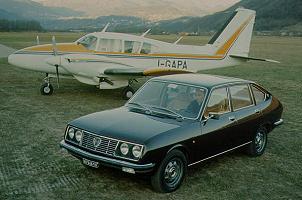 The
Lancia Beta was the first car developed by Lancia after it's purchase by
FIAT in 1969. Work started in January 1970 and it was presented for the
first time at the Turin motorshow in November 1972 as a berlina (saloon)
with 1438cc (90bhp), 1592cc (100bhp) and 1756cc (110bhp) engines which
were developments of FIAT's new twin cam engine for the 132.
The two box four door body was designed at the Fiat styling centre by Mario
Boano since the Lancia studio was already working on the next variant.
The
Lancia Beta was the first car developed by Lancia after it's purchase by
FIAT in 1969. Work started in January 1970 and it was presented for the
first time at the Turin motorshow in November 1972 as a berlina (saloon)
with 1438cc (90bhp), 1592cc (100bhp) and 1756cc (110bhp) engines which
were developments of FIAT's new twin cam engine for the 132.
The two box four door body was designed at the Fiat styling centre by Mario
Boano since the Lancia studio was already working on the next variant.
The Montecarlo was only weakly connected
with the Beta family, it had been previously designed (by Pininfarina)
as a prototype FIAT (first the X1/8 and later the X1/20) with various engines
(including the 2800 V6 from the 130), but
in the end the Beta drivetrain (complete engine, clutch, gearbox and diff)
was adopted, albeit behind the seats and tilted back slightly. The engine
was also enlarged to 1995cc by increasing the stroke, producing 120bhp.
The cockpit was reasonably roomy, and there was a quite roomy luggage compartment
under the bonnet, the spare wheel being stored next to the engine at the
rear. The 'Spider' variant featured an opening roof, really a full size
sunroof. It was sold as the Scorpion in the USA, fitted with an emissionised
1756cc unit with only 81bhp. This poor output, combined with an increase
in weight of some 30kg meant that the performance in that market was rather
disappointing. Various other detail changes were made to meet US legislation
such as bumpers and lights (which raised slightly in use). More images of the Montecarlo can be seen
here.
Yet further removed from the Beta family
was the 037 or 'Rally' which was developed from
the Montecarlo for use in rallying.
In 1975 the range was revised. Minor external
changes were made to the styling, and the 1995cc engine replaced the 1756cc
engine in all models (except in some in the USA). The 1592cc engine was
replaced by one displacing 1585cc, whilst the 1438cc engine was discontinued.
All the engines were used across the berlina and coupe models - the latter
no longer having higher output units.
The third series berlina entered production
in 1979 and included a restyling both inside and out (including the adoption
of the 'new' shield shaped grille) and the discontinuation of the 1300
engine. A year later the range was joined by a new design, the Trevi, a
conventional three box saloon with a most unconventional dashboard
designed by Mario Bellini. This was also the first Beta application of a
new fuel injected version of the 2000 engine with 122bhp. In 1981 the fuel
injected 2000 engine was added to the coupe and HPE, and power steering became available.
The Montecarlo suffered from a lack of
go in it's US spec (it's primary market) and poor brakes (the front wheels
had less weight and servo assistance and tended to lock up too easily,
whilst the rear had more weight and no servo). Production was stopped in
1978 and restarted in 1980 (not for the US) with numerous modifications,
to improve the braking (bigger discs and no servo), reduce the weight (down
by 70kg) and increase the torque (higher compression ratio). Some minor
cosmetic work was also carried out, including new wheels, new grille,
new wing mirrors and a few other minor changes. It never really took off
though, and production ceased in 1981 the same year as the berlina ceased
production. In the following year the Spider also stopped being produced.
These final versions, the coupe, HPE and
Trevi continued in production until 1984.
The Beta family was involved in motorsport
in a variety of ways. The Beta Coupe was used in rallying (with the 16V
cylinder head from Abarth) and helped Lancia win the World Championship
with the higher profile Stratos. The 037
was developed from the Montecarlo, even if very far removed, and achieved
many successes in rallying, including one World Championship. And the Montecarlo
itself was used with success in endurance racing, the Montecarlo turbo
winning two World Championships. In club racing the Beta Coupe proved popular
in many countries, and still continues to see action in various club events.
Approximate production volumes were as follows :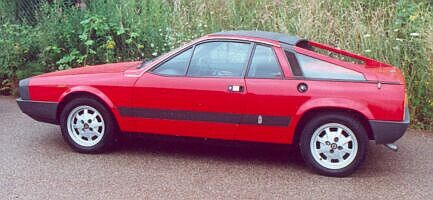 In
1975, at the Geneva Motorshow, the Beta range was again supplemented, this
time by the HPE (High Performance Estate) and Montecarlo. The former was
approximately what we now call a 'lifestyle estate', more a roomy five
seater with a hatch than a load-lugging estate car. It used the floorpan
(and hence the longer wheelbase) of the berlina, but the front end copied
the design of the coupe and there were only two doors.
In
1975, at the Geneva Motorshow, the Beta range was again supplemented, this
time by the HPE (High Performance Estate) and Montecarlo. The former was
approximately what we now call a 'lifestyle estate', more a roomy five
seater with a hatch than a load-lugging estate car. It used the floorpan
(and hence the longer wheelbase) of the berlina, but the front end copied
the design of the coupe and there were only two doors.
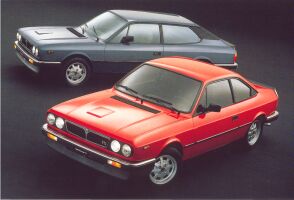 Small changes continued to be made to the range. In 1976 the 1297cc engine was
introduced into the coupe, and from 1978 an automatic gearbox was offered
as an option on the 1600 and 2000 cars, whilst all the cars got electronic
ignition. A minor facelift was carried out on the coupe, HPE and Spider
and the 1297cc engine was enlarged to 1301cc.
Small changes continued to be made to the range. In 1976 the 1297cc engine was
introduced into the coupe, and from 1978 an automatic gearbox was offered
as an option on the 1600 and 2000 cars, whilst all the cars got electronic
ignition. A minor facelift was carried out on the coupe, HPE and Spider
and the 1297cc engine was enlarged to 1301cc.
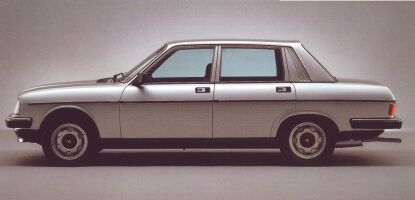 The ultimate production engine for the Beta family was the Volumex, a 1995cc
engine with a supercharger. This was introduced in the Trevi in 1982 with
135bhp and more importantly, considerably more torque. The VX HPE and coupe
models were introduced in 1982 and also received a stiffer suspension and improved brakes.
The ultimate production engine for the Beta family was the Volumex, a 1995cc
engine with a supercharger. This was introduced in the Trevi in 1982 with
135bhp and more importantly, considerably more torque. The VX HPE and coupe
models were introduced in 1982 and also received a stiffer suspension and improved brakes.
| Berlina : | 195,462 |
| Coupe : | 111,801 |
| HPE : | 71,258 |
| Trevi : | 36,784 |
| Spider : | 9,390 |
| Montecarlo : | 7,595 |
Technical Details
| Driveline | transverse engine at front with front wheel drive |
| Suspension | front : MacPherson strut with telescopic dampers and coil springs plus anti-roll bar
rear : independent with telescopic dampers and coil springs, twin transverse links and anti-roll bar wheelbase : 2540mm (saloon & HPE) or 2350mm (Coupe & Spider) track (front/rear) Berlina : 1405mm/1390mm |
| Brakes | front : discs
rear : discs calliper piston diameters : 45mm (front), 34mm (rear) handbrake operating on the rear via cable dual hydraulic circuit with servo assistance |
| Gearbox | 5 speed manual
3 speed automatic cable operated clutch disc diameter : 200mm (1300,1400 & 1600), 215mm (1800 & 2000) |
| Steering | Rack and pinion
ZF power assistance on some models |
| Engines | click here for details |
| Kerb Weight | early RHD models : Berlina (1600) : 1085kg; Coupe : 990kg; HPE : 1060kg; Spider : 1050kg
early US models : Berlina : 1119kg; Coupe : 1088kg Montecarlo : 1040kg (srs I); Scorpion 1070kg; srs II : 970kg |
Click here for sections through a Beta Montecarlo.
Click here to see the external body colours of the Beta range (Coupe, Saloon & HPE) ca 1978.
For dimensional drawings of the Coupé chassis see here, here and here.
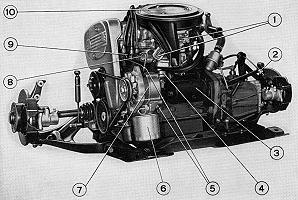
|
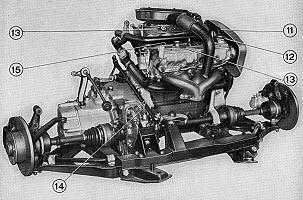 |
Performance
| model | max speed | 0-100km/h | standing km | Braking (from 100km/h) |
| Berlina 1600 (1979) | 170 km/h | 11.1 sec | 33.1 sec | 55.1 m |
| Berlina 2000 (1977) | 180 km/h | 11.2 sec | 32.1 sec | |
| HPE 1600 (1977) | 174 km/h | 33.5 sec | ||
| Coupe 1300 (1977) | 163 km/h | 13 sec | 34.8 sec |
Tuning
There are three main areas to concentrate on, the engine (and transmission), the brakes and the suspension and then various other details. These three should be done together since they complement each other, not all of one and none of another !
1. The engine.
Before modifying the engine it is worthwhile filling it with a good quality synthetic oil and fitting new spark plugs. An engine oil additive may also be used.
The first improvements are relatively simple. The air filter can be replaced for an aftermarket item which will help the engine breathe more freely, the type which completely replace the original airbox are best, and the exhaust can be replaced for one which will restrict the exit of the gases less. The whole system should be replaced, not just the rear section.
The main modification (outside of taking
the engine apart) is to fit a better carburettor(s). A pair of twin 45
DCOE's are a good choice (40's on a 1600 or smaller). Downdraught setups
are also possible, but the sidedraught one is to be preferred. A camshaft 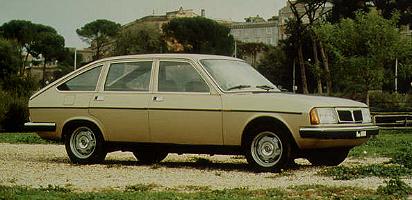 will
also provide a noticeable gain, especially if fitted in conjuction with the carburettor.
will
also provide a noticeable gain, especially if fitted in conjuction with the carburettor.
Other things to do should include fitting
a cold air intake, a large diameter pipe (minimum 5cm) to provide air from
outside the engine bay to the air filter. The exhaust manifold can also
be lagged with thermal cloth or tape to keep the exhaust gases hotter (and
thus reduce back pressure) and also to keep the underbonnet (and hence
intake and fuel) temperatures lower.
The high tension leads can also be replaced with performance ones.
Further modifications require the machining of the cylinder headand/or cylinder block (which will not be dealt with here since it is not normally a DIY job) after which it may be worth fitting an oil cooler. If overheating is a problem due to the increased power output then a small hole can also be drilled through the plate in the thermostat. There are a multitude of company's with experience of internal cylinder head modifications for the Lancia twin cam engine, and a 1995cc engine with 45 DCOE's and a gasflowed head should produce over 150bhp.
Regarding the transmission the main requirement is to uprate the clutch to handle the increase in power and torque achieved though the engine modifications. Friction plates can be purchased with improved materials and heavier duty pressure plates are also available. Whilst doing this it is worthwhile lightening the flywheel.
2. The brakes.
Initially it is relatively easy to replace
the brake discs with drilled and grooved items, and the pads for a harder
compound. The latter should not be too hard (ie no race pads on the road)
or they will not function effectively at the normal 'road' operating temperatures. If more serious braking is required the
next modification would be to increase the disc size. It is possible to
use larger discs with a bracket allowing use of the production callipers,
or alloy four pot callipers can be fitted.
In order to improve the balance of the
car under braking it is desireable to be able to adjust the balance of
braking from front to rear (and vice versa). This can be accomplished by
fitting a bias valve in the line to the rear brakes, usually in a position
so that it can be reached from the drivers seat.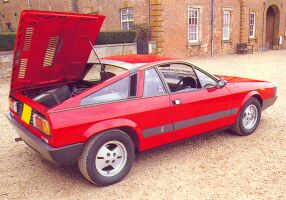 Stainless
steel braided flexible hoses will improve the pedal feel and reduce the
chance of damage whilst DoT5 fluid (not silicon) will increase the temperature
at which it can operate effectively. If the brakes are getting too hot
the dustguards can be removed and/or ducts fitted, taking air from behind the front bumper.
Stainless
steel braided flexible hoses will improve the pedal feel and reduce the
chance of damage whilst DoT5 fluid (not silicon) will increase the temperature
at which it can operate effectively. If the brakes are getting too hot
the dustguards can be removed and/or ducts fitted, taking air from behind the front bumper.
3. The suspension.
The easiest improvement,and the one which
will probably bring the single most noticeable change, is to replace the
dampers and springs. Fitting lowered springs will improve the cornering,
but must be fitted together with shortened throw dampers, or else the springs
may unseat ! Top adjustable dampers are compromised, but are good for road
and track day cars since it allows the suspension to be adjusted between
these two, rather different, requirements. Coil over units add more adjustability
and can be purchased outright, or can be made from standard dampers by
welding a threaded sleeve to the standard tube.
There are then two other main suspension
aims; to reduce the flexiblity in the suspension and to increase the stiffness
of the car, both of which aim at more accurate control of the wheel movement.
To reduce the flexibility it is possible to fit nylon bushes instead of
the normal production rubber items, or if perfection is desired the suspension
can be fitted with metallic bearings (rose joints / rod Into this category also fall the choice
of wheels and tyres. With an increase in power it can be necessary to fit
larger tyres (thus requiring larger wheels) but the temptation to fit the
biggest possible should be resisted. Consideration should be given to fitting
a wider tyre on the front (since they provide traction and steering) but
keeping the standard, or a wider but not as wide as the front, tyre at
the rear. This will improve the balance of the car.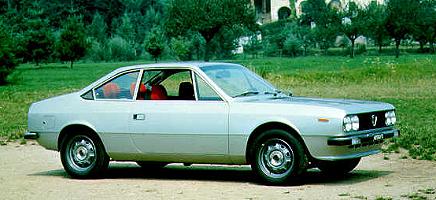 ends).
Spherical bearing top mounts can also be used. To stiffen the car it is
most popular to fit strut braces. These can be fitted to the front and
rear. For more extreme cases a rollcage can be fitted.....
ends).
Spherical bearing top mounts can also be used. To stiffen the car it is
most popular to fit strut braces. These can be fitted to the front and
rear. For more extreme cases a rollcage can be fitted.....
4. other things.
Other modifications worth considering include fitment of a shift light (and rev limiter if there is not one as standard), higher power bulbs in the headlights (if you are going to go faster you need to see further) and installation of a quicker steering rack.
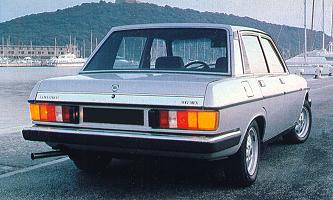 Maintenance
Maintenance
Change the cambelt every 36,000 miles !
More information coming soon.
Buying / Selling
Berlinas are quite rare, but are probably
the cheapest to buy today. The HPE and Coupe are similar in price (although
Coupes will normally be a bit more expensive). The Spider generally fetches
the most money, whilst Volumex cars are more in demand, and rarer, so they
command a premium over the other versions. The Trevi offers a lot of car
for (usually) not a lot of money. Power steering, fitted to later models is advantageous.
Some tips to do before selling :
(they may seem obvious, but most people don't do them and thus are in a weaker bargaining position)
Tidy inside the car thoroughly : hoover
the floor, empty all pockets, ashtrays (wash), glove compartment etc...,
wipe the trim with a damp cloth, give the cockpit a good airing to get
rid of any odours ! Reset the trip meter to 00000 - it is a pleasant (subconcious) surprise.
If the car has been standing give it a
good run - this will clear out the engine (reduce exhaust smoke), put a
shine on the brake discs 'Back to black' products are very effective
at temporarily restoring bumpers and trim. This makes a big difference
to any car. Do it a week before you expect people to view the car, otherwise
it may be a bit too obvious !
Jetwash under the car, especially under
the engine and in the wheelarches. The prospective buyer may be an enthusiast,
and this makes it easier for them to see what they want to check.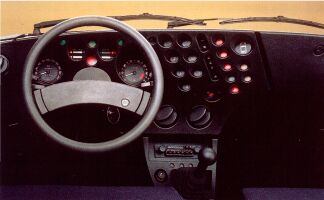 and
loosen up any joints that may otherwise make some noises.
and
loosen up any joints that may otherwise make some noises.
Obviously wash the car and clean the windows !
If you are going to buy a car always check the following :
Especially on Beta's it is necessary to
check the bodywork. Pay special attention to the wheelarches (inside if
there is no plastic splash guard), suspension and engine mounts, sill,
door pillars (check for sagging doors), scuttle panel and the floor (doors,
bonnet and boot/hatch are also susceptible, but are more easily replaced).
If a sunroof is fitted check around the edge for signs of rust. Check that
there are no mismatching panels, large areas of discolouration or signs of fresh paint.
Check for a damp carpet or the presence
of mould - if the carpet is damp then the floor is almost certainly corroded.
Check the main electrical functions - wipers,
windows, etc... try putting the main beam and wipers on at the same time.
Check the headlight reflectors for rust.
Check the brake pedal does not go to the
floor if pressed hard for a long time and check the gearchange for clean
engagement. Inspect the driveshaft gaiters for signs of leakage - an awkward
job, and the joints can also be damaged.
Check tyre wear, uneven patterns could imply a bent chassis.
Always take it for a test drive. Check
that the car tracks in a straight line with no steering input and remains
in a straight line under braking. Find a large open area and complete several
lock to lock turns (also in reverse), listening for any noises. Try the
handbrake when moving - seized rear callipers will mean uneven braking or no braking.
Generally, Lancia Beta's are mechanically
pretty good, but the bodywork was weak.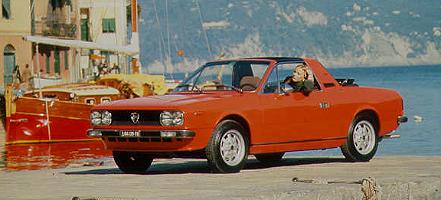 The engine should be run up to temperature, check the exhaust for smoke, the
condition of the breather (look for mayonnaise), the condition of the oil
filler cap (again white deposits can indicate head gasket or other serious
problems) and the colour of the coolant (preferably not brown!). If the
car has an oil pressure guage this should not drop below 1 bar at idle,
and should be around 3 to 4 bar at speed. Listen to the noise of the engine,
then depress the clutch and engage first gear. Whatever noise has disappeared
was coming form the gearbox, what remains is from the engine. Check the
colour of the oil using the dipstick. A golden-brown is best, darker brown
is ok, but thick and black should be avoided.
The engine should be run up to temperature, check the exhaust for smoke, the
condition of the breather (look for mayonnaise), the condition of the oil
filler cap (again white deposits can indicate head gasket or other serious
problems) and the colour of the coolant (preferably not brown!). If the
car has an oil pressure guage this should not drop below 1 bar at idle,
and should be around 3 to 4 bar at speed. Listen to the noise of the engine,
then depress the clutch and engage first gear. Whatever noise has disappeared
was coming form the gearbox, what remains is from the engine. Check the
colour of the oil using the dipstick. A golden-brown is best, darker brown
is ok, but thick and black should be avoided.
Links
A website dedicated to mid engined Beta's, mainly the MonteCarlo
The UK Montecarlo Consortium website
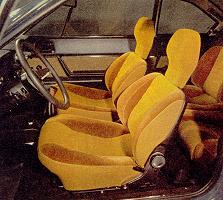
|
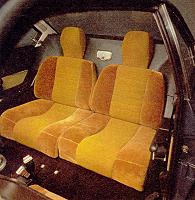 |
Lancia Beta Books : buy
them online here (in association with
Amazon)
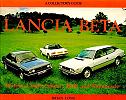 Lancia
Beta : Berlina, Coupe, Spider, HPE & Montecarlo : A collectors guide
Lancia
Beta : Berlina, Coupe, Spider, HPE & Montecarlo : A collectors guide |
Brian Long, 1991 |
 Lancia
Road Test Book : Lancia Beta Gold Portfolio 1972-84
Lancia
Road Test Book : Lancia Beta Gold Portfolio 1972-84
Numerous articles on the Berlina, Trevi, Coupe, Scorpion, Montecarlo, HPE and Spider. Over 300 illustrations. |
Edited by R.M.Clarke, 1993 |
For more books Lancia's, see our Online Bookstore
Beta comment form
Your Comments
I loved my 81 beta 1600 saloon,
great engine handling torque fun to drive, when i saw the crazy dash with
all those buttons i had to have it, nice velour, crap headlights, comfortable
seats pity about the ongoing everexpanding electrical frustrations and
the rampant rust.... (bodie & doyle, new zealand)
I regret selling my 1982
Beta Berlina 2litre of the hundreds of cars I`ve owned this was one of
my favourites-nicer car than the Beta coupes the HPE`s and Monte Carlo
that I`ve owned as well as the numerous Alfas, BMW`s,Fiats, Porsche`s etc.
It had beautifully weighted power steering,superb wool cloth seating and
headlining, a particularly smooth and torquey motor compared to the same
engine in the other versions(must have been different mountings?) and handling
similar to my Alfasud Ti although because of the heavier weight not as
agile. It was a superb touring car with huge boot,great interior space,
excellent ventilation and it was different. The dash was a continuous source
of comment from everyone who saw it and the car looked absolutely superb
in Lancia Blue(Navy) with its special alloy disc wheels special to the
2 Litre Berlina and Trevi. A great car missed greatly but sometimes you
don`t know what you`ve got until you no longer have it.
I miss my 76 beta 2000ES berlina so much, it was metallic bronze with the burnt orange interior, sunroof, full electrics and genuine campagnola mags.
My wife made me sell it because it was so ugly, true it was, but that lusty twin-cam pulled like the proverbial...now i have a 76 peugeot 304 wagon with 1127cc of trobbing grunt !
(Brendan C, New Zealand)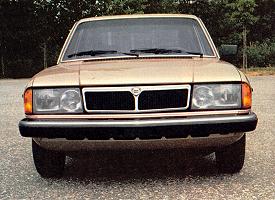 I have a 77 2000 Beta coupe,
great car has very good high speed stability, great handling,lot's of revs,
interiors good: can fall apart if not looked after, always check gear linkage
wear and clutch linkages (a pain to fix) and check the usual for rust (ills
etc.etc)electrical can be touchy, I love it.
I have a 77 2000 Beta coupe,
great car has very good high speed stability, great handling,lot's of revs,
interiors good: can fall apart if not looked after, always check gear linkage
wear and clutch linkages (a pain to fix) and check the usual for rust (ills
etc.etc)electrical can be touchy, I love it.
There is also a list of all our picture galleries (including museums, motorshows and various events).
Wallpapers/Desktop Backgrounds of numerous Lancia's are available to download.
See also our Lancia advertisements gallery, where several adverts can be seen.
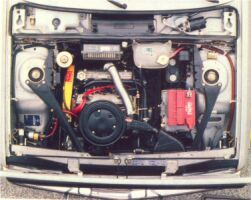
Use the buttons at the top to navigate further, or
Copyright © 2000 to 2008 CarsfromItaly